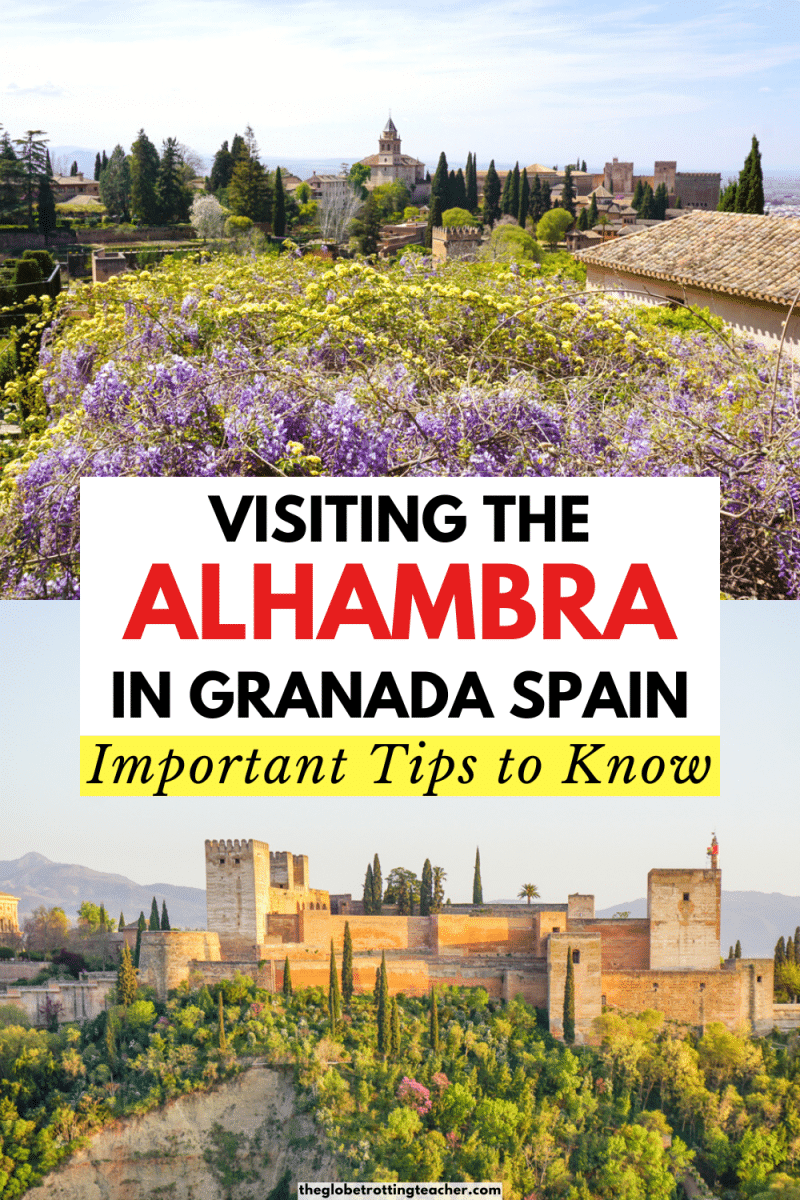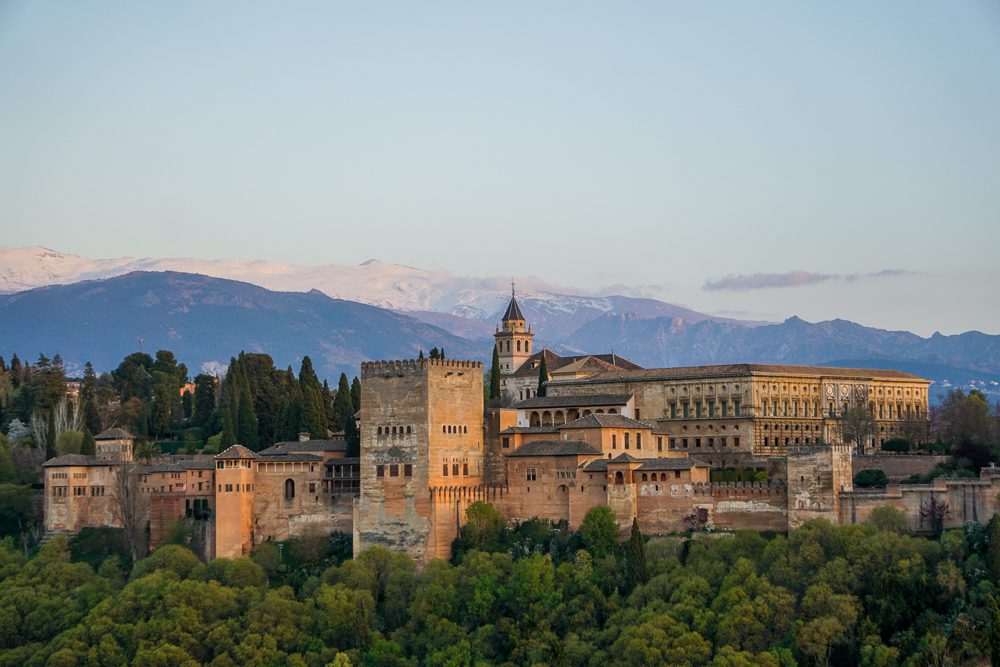Visiting the Alhambra in Granada Spain is a must-do! And the nearly 3 million people who visit Spain’s most visited site each year would wholeheartedly agree.
The Alhambra is one of the most beautiful places anywhere in the world. Its cultural, historical, and architectural significance is rooted in every corner of the complex from the cypress trees in the Generalife gardens to the exquisite ornamental carvings and geometric designs blanketing the walls and keyhole arches in the Nasrid Palaces.
So in this guide, you’ll find everything you need to know for visiting the Alhambra palace complex including in-depth ticket information, historical context, and many other tips for visiting the Alhambra successfully!
History of the Alhambra
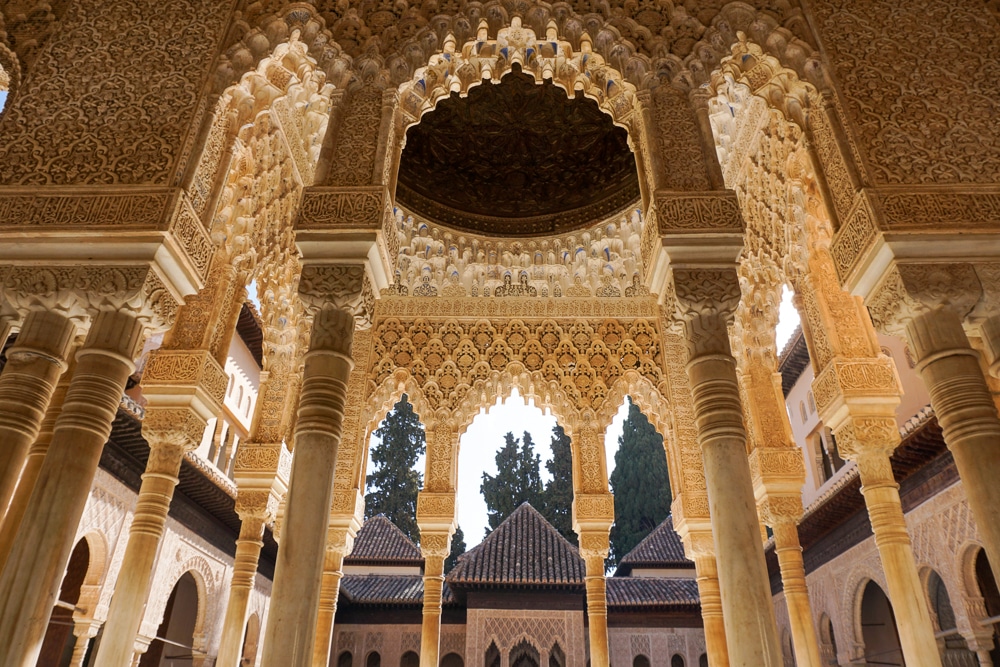
The teacher in me can’t help but begin with a history lesson!
The Alhambra Palace is by far the most famous monument in Granada and amongst the greatest treasures in the whole of Southern Spain! It exceeds Cordoba’s mosque in beauty and matches the impressive architecture of Seville’s cathedral and Alcazar.
It slowly grew into the citadel you see today over hundreds of years. The Alhambra was built from a reddish mud found on the cliffs where the palace was constructed, and this very material is the palace’s namesake. Etymologically speaking, the word comes from the Arabic for “red castle” – the perfect fit for the majestic Alhambra.
Although it is often thought of as a royal palace, the Alhambra had many roles before it became the home of kings in the 13th century. Many fortifications existed on the hillside since the 9th century, but the Alhambra’s grand and exquisite palaces and gardens began their construction in 1238.
The founding king of the Alhambra, Muhammad Al-Ahmar, began by restoring the existing fortifications and the old fort, and later in the 14th century Yusuf I and his son Muhammed V ordered the palaces be built. This is when the most beautiful areas of the Alhambra, like the Hall of Lions and the Casa Real Vieja appear.
Did you know that the Alhambra was the last stronghold of the Nasrid Kingdom in Spain? The Moors were kicked out of Andalucia, formerly known as Al-Andalus after it was under Moorish rule (for more than 800 years!) by the Reyes Católicos (Catholic Monarchs) in 1492 with the conquering of Granada.
After this, the Alhambra switched hands and became a Christian court. Christian structures, like a Church and a Franciscan Monastery, were added, as well as military barracks and housing for prominent figures.
Much later, in 1984, the Alhambra was recognized as a UNESCO World Heritage Site along with the Albaicín neighborhood and the Generalife Gardens.
Visiting the Alhambra History Cheat Sheet
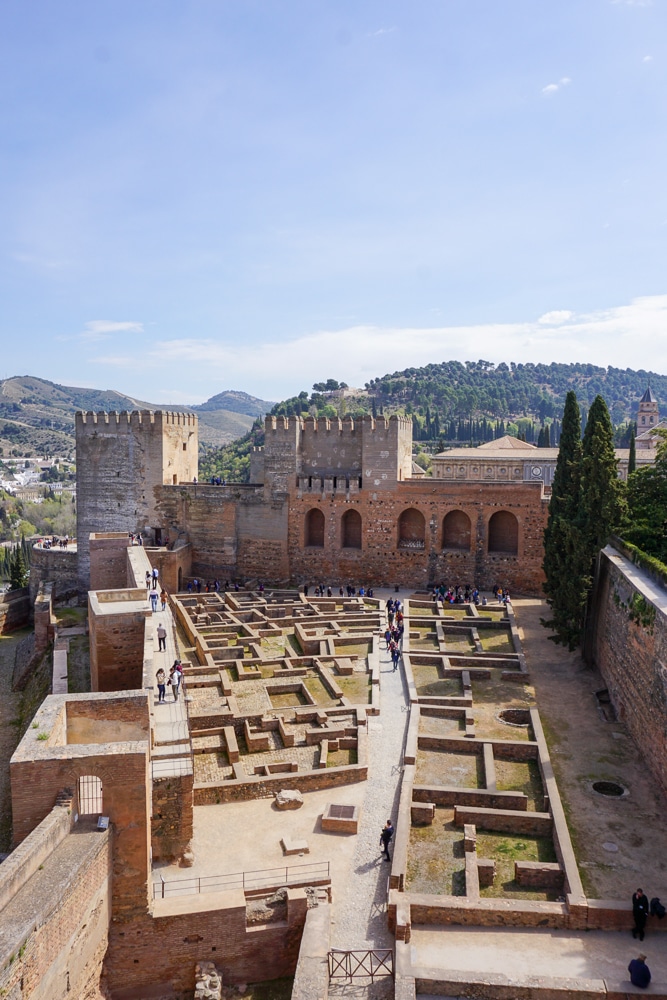
And just in case I lost you in the history lesson above, here are the basic history dates and facts so that you can look like an expert while visiting the Alhambra.
- Military fortifications and forts have existed on the site since the 9th century.
- In the 13th century, it became the royal residence of King Muhammad Al-Ahmar.
- The Nasrid Palaces were built in the 14th century.
- The Alhambra’s name is rooted in the Arabic for “red castle”.
- In 1492 this once Moorish territory was conquered by the Catholic Kings and the eviction of the Moors from Spain began.
- The Moors reigned parts of Andalusia (formerly Al-Andalus) for more than 800 years, from the early 8th century to the late 15th century, and Granada was their last stronghold. That’s why you’ll see this unique fusion of cultures from Ronda and southern Spain’s white villages to Tarifa.
- The Alhambra became a UNESCO World Heritage Site in 1984.
Different areas of the Alhambra

When you get your official Alhambra map downloaded on your phone or at the ticket office you’ll see that the map is broken down into a few broad regions. It’s easiest to think of the palace as made up of the Generalife, the Nazarid Palaces, the Alcazaba, and El Partal which is by the Palacio de Carlos V and is also known as Charles V Palace.
Generalife
The Generalife gardens start as soon as you walk through the main entrance of the Alhambra. First, you stroll down a long dirt track through a wooded area which leads you to a spectacular garden with delicate water features that were designed to keep the palace cool.
The gardens feel like a long maze of smaller gardens, and at the end, there’s the quintessentially Arabic-looking Generalife Palace. As beautiful as the Generalife is, there’s a lot to see and I don’t recommend starting your day here.
El Partal
As you walk through the entrance area, head towards the Medina and the Partal. It’s one of the smallest areas in the Alhambra but also one of my favorites. The geometrical carvings on the stone walls of the Oratorio del Partal are so impressive. The gardens in the Partal, with their geometric pools, are beautifully tranquil.
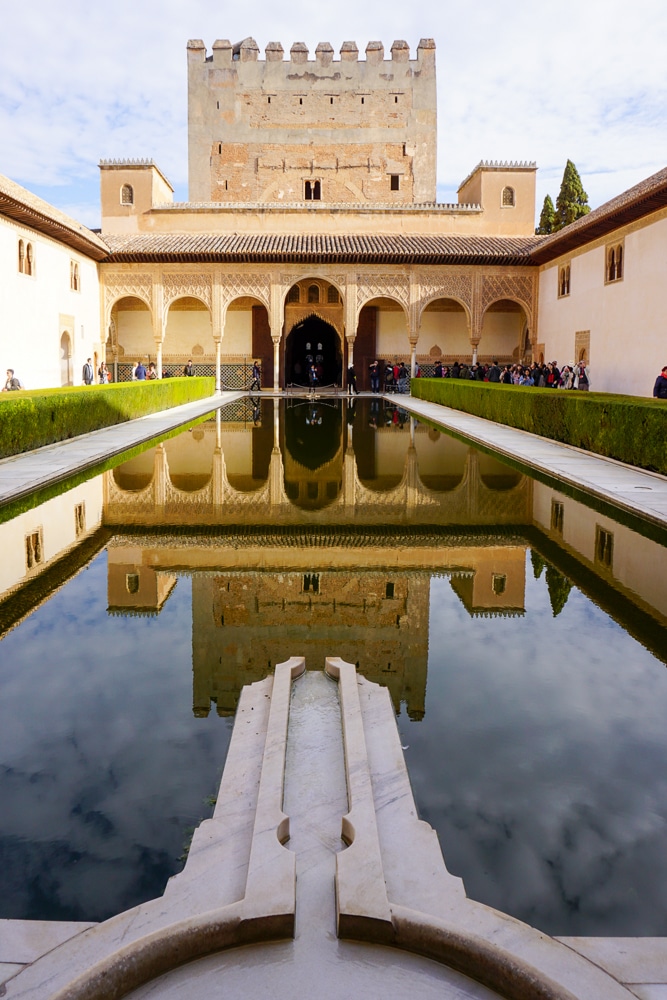
Nasrid Palaces
And next, we have the most famous area of the Alhambra, the Nasrid Palaces. Pretty much every brochure picture you’ve seen of the Alhambra was shot here. The palaces encompass the Palacio de los Leones (Palace of the Lions), the Hall of Ambassadors, the Mexuar, Comares Palace where the King once lived, and various halls and courts that once served the royalty.
It’s here that you get a real glimpse of the traditional courtyard layout that is still used in Spanish architecture today. The rooms and areas of the various parts of the Nasrid Palaces are built around inner courtyards with large pools of water and gardens. This kept everything cool in the hot summer months!
Palace of Charles V
Right next to the Nasrid Palaces, there’s the Renaissance Palacio Carlos V which is far from Arabic looking and was built after the Alhambra was conquered by the Catholic Kings. Construction of this palace began in 1527 but it wasn’t completely finished untill hundreds of years later when the roof was added in 1957.
Alcazaba
Beyond the palaces, there is the Alcazaba, the oldest part of the Alhambra. This area of the Alhambra is mostly made up of old forts and defensive areas as it was the military complex.
There are constructions in the Alcazaba that precede even the Nasrid period, and it’s thought that the first Arab constructions, done in the Caliph period, may have been built over the remains of a Roman fortification!
The most impressive of the towers in the fortified Alcazaba area is the Torre de la Vela, which is just shy of 89 feet tall. In the past, the bell at the top of the tower rang several times a day to alert farmers of when to irrigate along with other things.
Now however the sound of the bell only rings throughout the city once a year, on the 2nd of January, when all the famous women come to test their luck with a legend that says that anyone who rings the bell on that very day will be married before the end of the year!
Visiting the Alhambra: Tickets
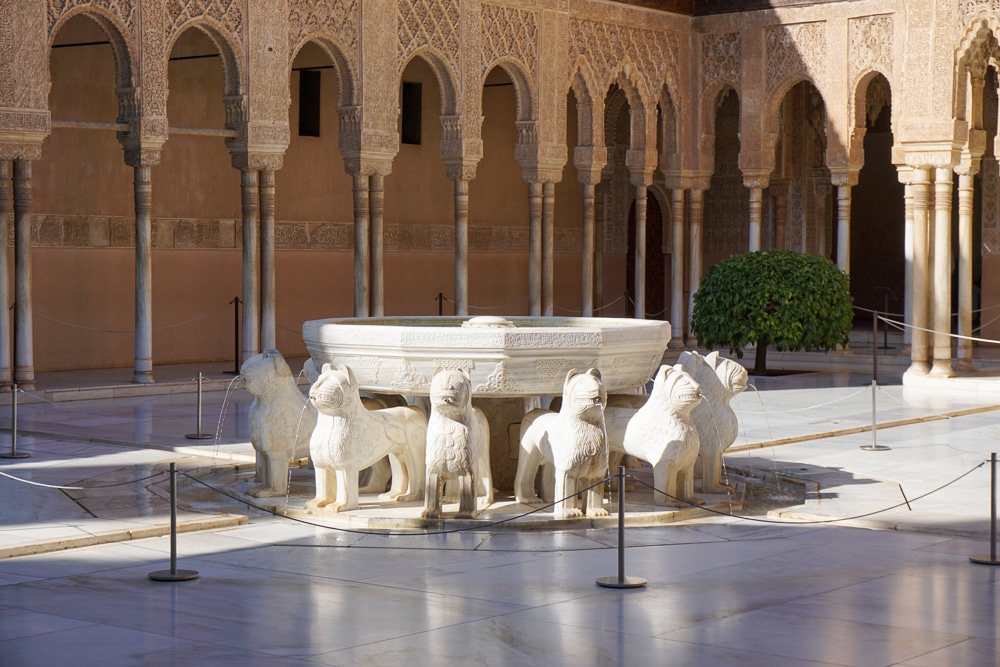
More so than any other sight you plan to visit as part of your Spain itinerary, it’s really important to get the tickets right for your Alhambra visit. It would be a real downer if you planned 1 or 2 days in Granada around seeing the Alhambra only to discover that there were no tickets to be had.
Book your tickets in advance!
No matter which article about visiting the Alhambra you’re reading, you’ll see the same advice when it comes to Alhambra tickets.
If you turn up to Granada and expect to get tickets for the Alhambra complex that weekend, you’re going to be very disappointed. Book your tickets as far in advance as possible so you can guarantee, first, that you’ll get in and, second, that you’ll get the best visiting time for the Nasrid Palaces.
Don’t believe me. Take a look at this screenshot taken at the start of January 2024.
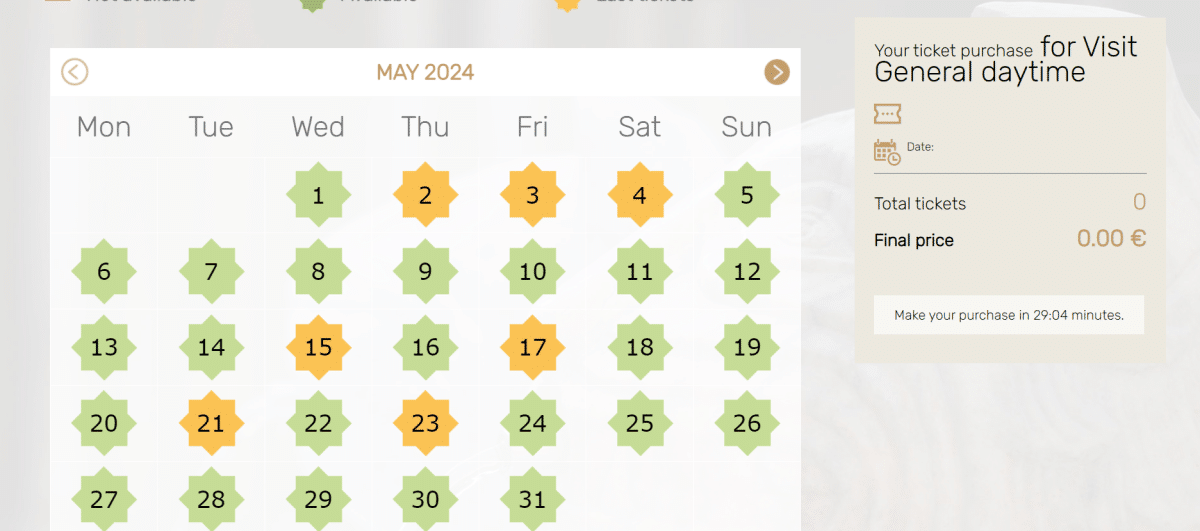
The calendar shows Alhambra ticket availability for May 2024. The green dates indicate that tickets are available. The yellow dates show the days when the “last tickets” are being sold. Nearly 6 months in advance there are already 7 days in May that are all but sold out.
Bear in mind, the Alhambra is limited to 6,600 visitors a day and the Nasrid Palaces are limited to 300 visitors per half hour. These capacity limits are firm and, unless you find last-minute tickets by joining an Alhambra tour, you’re out of luck for that date.
You can get your tickets up to a year in advance at the official website. The tickets are non-refundable and can’t be changed so be sure you choose the correct date.
Which Alhambra ticket is right for me?
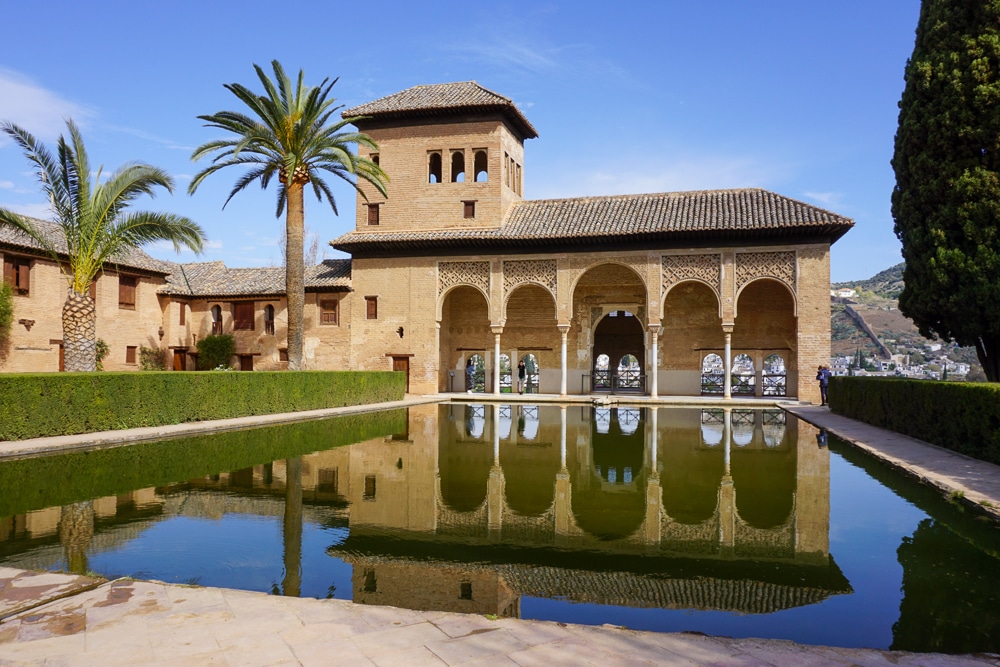
You can get different entry tickets for the Alhambra, and each gives you access to different areas of the palace. The Alhambra general ticket, which costs 19€, includes the Alcazaba, Generalife, Nasrid Palaces, and Partal. This is the best ticket choice for first-time visitors who want to soak in as much of the Alhambra as possible.
Alternatively, you can get a ticket for just the Generalife, Alcazaba, Partal, and some garden areas for just 10€. However, I don’t recommend this because you’d miss out on the Nasrid Palaces, the most beautiful part of the Alhambra.
If you’re staying in Granada for a long weekend or more, the “Dobla de Oro General” ticket includes a general ticket to the Alhambra and entrance to various famous sites around the Albaicin neighborhood.
It gives you access to the Bañuelo Arab baths, the Corral del Carbón, Dar al-Horra Palace, and more for just 27€!
You can also visit the Alhambra at night. Personally, I’ve only done an Alhambra night visit to see various concerts and shows they hold there in the summer months. I loved experiencing the Alhambra at nighttime, but I think, if it’s your first time visiting, it’s best to go in the day because you will lose a lot of the smaller details (like the stunning colors of the tile work inside the palaces).
When visiting the Alhambra, which ticket time is best?

When you buy tickets for the Alhambra, you’ll also select a time of day.
It’s really important to understand that this time refers to the time you can visit the Nasrid Palaces only. It doesn’t have anything to do with the time you enter the other parts of the Alhambra like the Generalife Gardens or Alcazaba. You can visit the rest of the Alhambra at any time on the date of your visit.
What’s of the utmost importance is being on time for your Nasrid Palaces entry. It’s even worth arriving up to 30 minutes before your time slot because if you’re late you won’t be allowed in, and would miss the best of the Alhambra!
So, with that, what time should you choose? In this case, it’s true the early bird really does get the worm. The earlier you go, the fewer people there will be making it easier to enjoy the Nasrid Palaces and other areas of the complex.
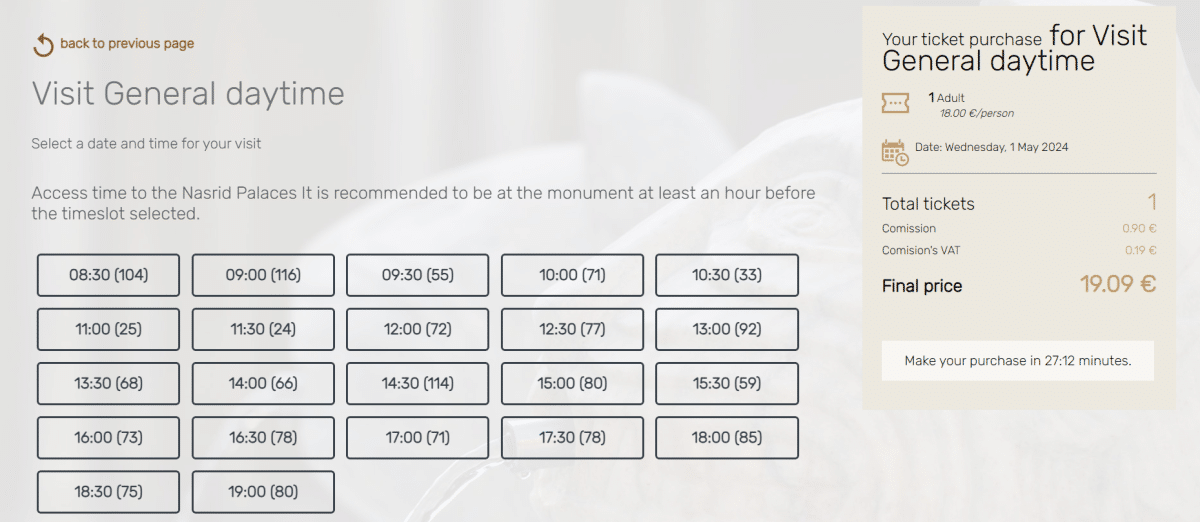
Again, this screenshot was taken at the beginning of January 2024 for tickets on May 1, 2024. Knowing only 300 people are allowed in each half hour, you can see how many slots are open.
Also note, that even at 5 months out, the late morning pre-lunch times only have 20-30 places left! These tend to be the busiest times to visit the Nasrid Palaces.
If you were able to enter at 8:30 or 9:00 in the morning, you’d see the palaces and be off to another part of the complex just as the busiest (and hottest) time of day arrived.
Alternatively visiting the Alhambra in the mid to late afternoon has its perks, too. You could visit the complex and save the Nasrid Palaces for last. The times just before closing are also less crowded.
Skip-the-Line Tickets for the Alhambra
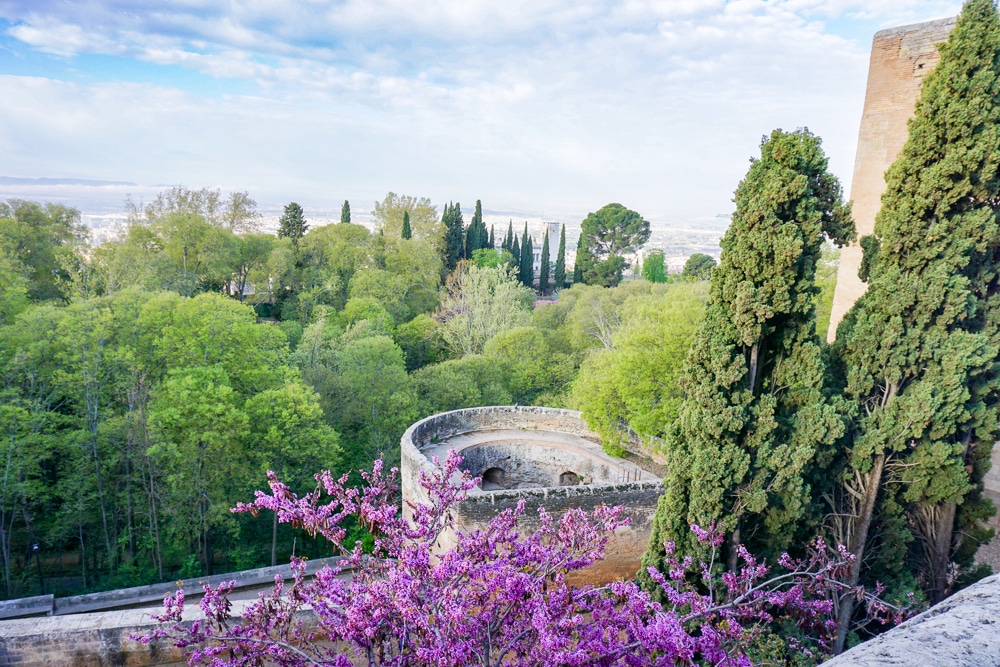
While it does cost a little bit extra, it could be worth opting for skip-the-line Alhambra tickets especially if you’re visiting the Alhambra during the spring and summer high season.
When you buy general tickets on the official Alhambra website, you get access to the entire complex. However, for each section, the Alcazaba, Generalife, etc., you’ll have to wait in line to enter each one. With a skip-the-line Alhambra ticket, you can do just that and bypass the lines, saving time and aggravation.
All the Alhambra tickets are sold out – HELP!
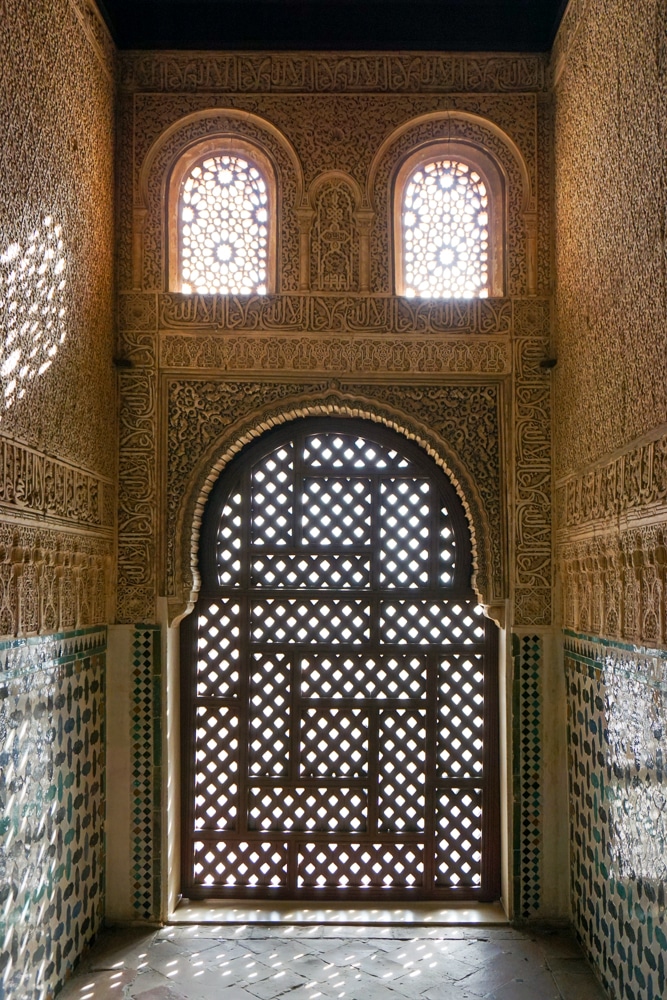
Don’t panic. If you go to book your ticket and everything is already sold out, all hope is not lost! You can still book an Alhambra tour that includes a ticket, or buy a Granada card (that includes entrance to other sites around the city as well as the Alhambra and bus trips. Plus you get to pick the day you want to visit).
The last case solution is to try and get same-day tickets on the official website starting at 12:01 a.m. on or at the vending machines outside the entrance on the day.
It’s far from the ideal scenario, but you can sometimes get tickets for the same day because guides and groups pre-book blocks of tickets and then potentially release some back when they don’t sell them.
There are also vending machines at Corral del Carbón, Bañuelo, and Dal al Horra that sell entrance tickets to the Alhambra palace, so if you’re already there and you want to try getting tickets last minute you’ve got a shot!
If worst comes to worst, you can try to purchase a different type of ticket (excluding the Nasrid Palaces) or still visit the free parts of the Alhambra. These include the Alhambra Museum, Palacio de Carlos V, Torre de las Cabezas, Carmen de los Martires, and the Puerta de la Justicia.
Visiting the Alhambra: Guided Tour or Independently – Which is best?
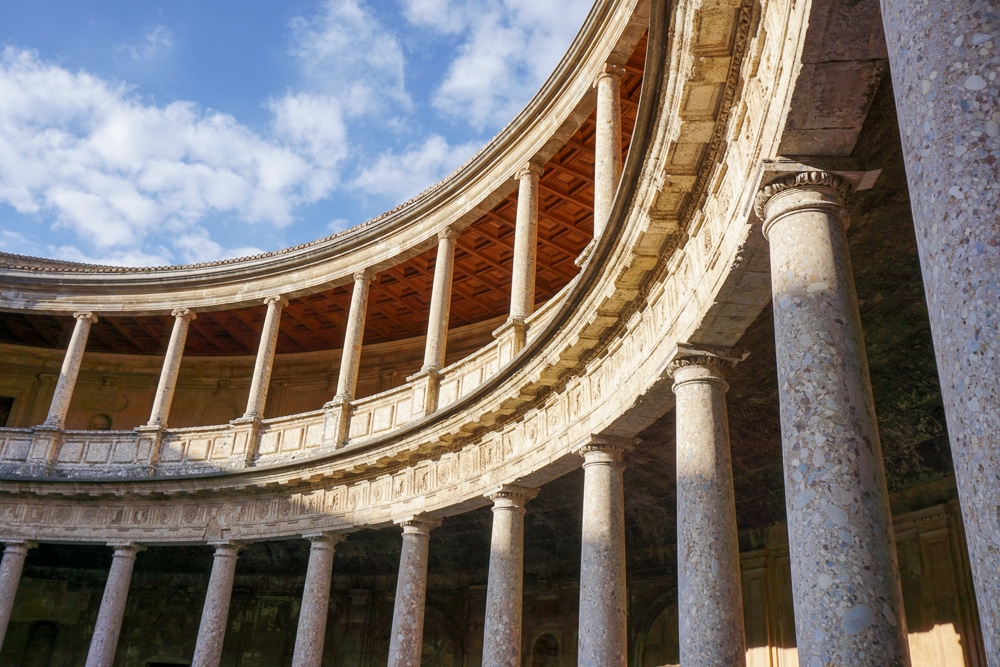
Another thing you’ll need to consider when you’re planning your trip to the Alhambra is whether you want to go independently or book a tour, ticket availability aside.
One of the main advantages of taking a tour is that the Alhambra is really big and there are so many areas that sometimes it can get a little overwhelming or you miss out on the best places because you didn’t go down the right path.
Having an expert guide means you’ll get to see everything in the most efficient way, plus you’ll get lots of extra facts about the Alhambra’s architecture and fascinating history stories.
Having said that, if you go independently you’ll have more autonomy about which areas you spend most time in, and you can skip any areas you’re not interested in. Going independently will also lend to a more relaxing and introspective visit.
Another pro of visiting the Alhambra independently is that it will be cheaper, so if you’re on a budget then it’s a better option than a tour.
Overall, if you like getting lost in your thoughts and strolling or you need to save money, go independently. Whereas if you love history or architecture and you’re here to learn everything you can about the Alhambra, go on a tour.
A compromise is to pay for the Alhambra audio guide at the entrance. That way you can go independently but still enjoy the perk of an in-depth guide on each of the palace’s areas. They have a 2 or 3-hour audio tour option for rent.
You can also get audio guides through apps on your smartphone, so take a moment to browse the different options available.
Visiting the Alhambra with a Guide: Which Tour to Book
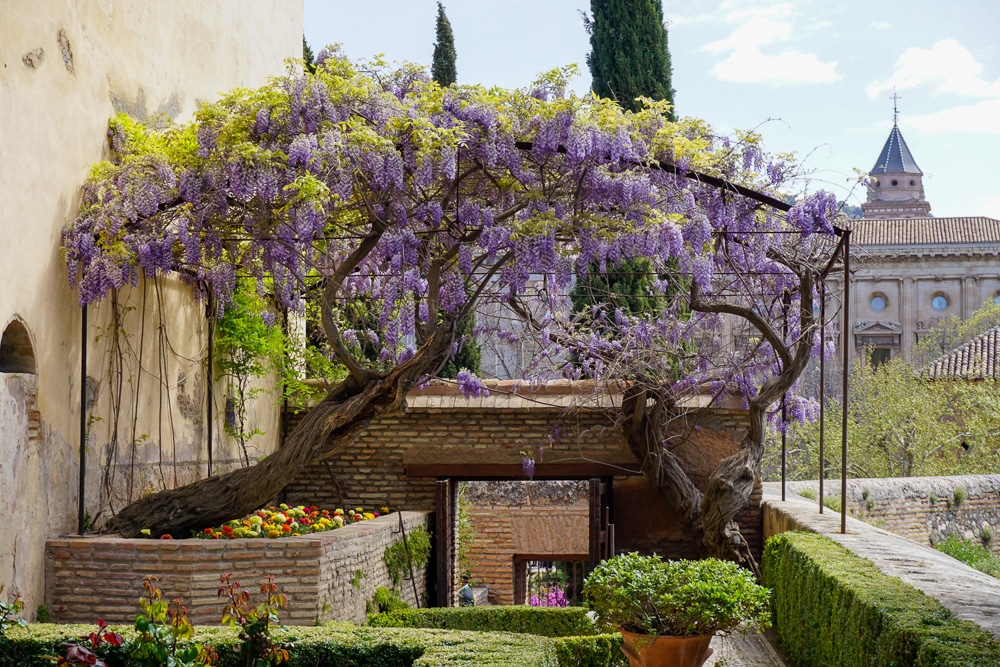
If you decide to take a guided tour of the Alhambra, this popular 3-hour tour includes fast-track entry to the Nasrid Palaces, the Garden of Generalife, and the Alcazaba, as well as other stops throughout the complex. As you tour the grounds, the guide will provide historical context and architectural information for a deeper understanding of this one-of-a-kind sight.
Visiting the Alhambra as a day trip from a city like Malaga is worth considering if you’re staying outside of Granada as it’ll save you from having to switch hotels, and work out about the same price anyway!
Visiting the Alhambra: How to Plan Your Time
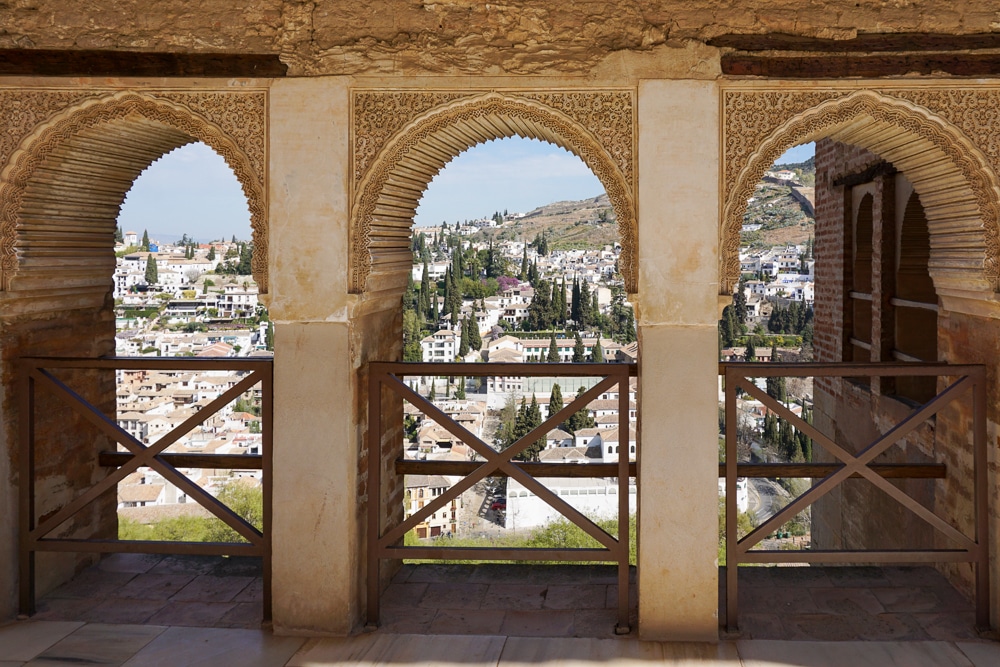
It’s best to build your visit to the Alhambra around the early morning and pre-lunch hours or later in the afternoon until near closing time. Personally, for a place so vast with a lot to take in, I would recommend starting your day in Granada at the Alhambra.
Avoiding the mid-day hours is a great way to beat the crowds and the heat in summer.
If possible, start when the Alhamra opens with the Nasrid Palaces. Choose a morning entry time so that you can visit these palaces at the time of day with the least people, especially the tour groups that arrive later on.
After this spend time seeing the Palace of Charles the V and then make your way to see the Alcazaba. Loop back and if you haven’t yet, take time to see the Partal and the Medina before making your way to the Generalife area.
Plan for your visit to last roughly 3 hours, although it could take longer depending on your pace, how long you stop in each area, and the number of people visiting the Alhambra at the same time as you.
Also, know that you don’t have to rush! Your ticket is good for the day (except for the specific timed entry at the Nasrid Palaces). So if you’d like to stop for a break, you can without worrying that you won’t have time to see everything else.
Best Time to Visit the Alhambra
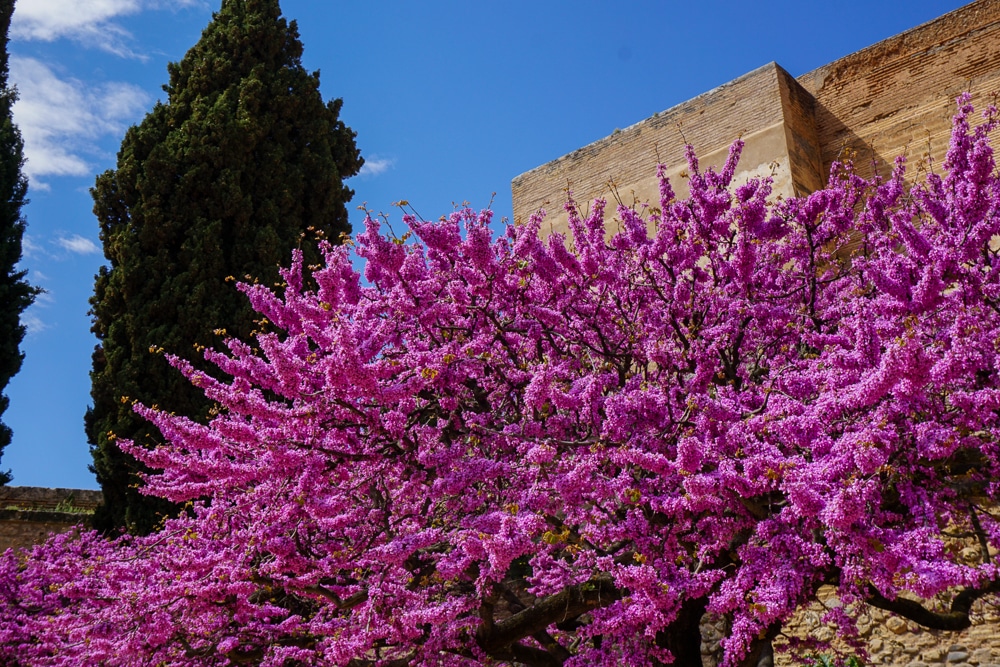
In spring and autumn, the temperatures are pleasant and mild, and there’s not much rainfall either! They’re the perfect seasons to visit the Alhambra. It’s also when the garden’s colors will be at their brightest, whether they’re sprinkled with burnt orange leaves or blossoming flowers.
In the winter, Granada gets quite cold because of the snow-topped Sierra Nevada mountains that rise over the city, so it’s best to go early in the afternoon when the winter sun is at its warmest. This is also the least busy time of year. It’s not as necessary to book early morning visits as it is during the other seasons.
On the other hand, in summer it’s the opposite. Temperatures in southern Spain can reach 100F+ degrees. It’s best to go early in the morning before the sun is out or to go at night, that way you’ll avoid the hottest hours of the day (which are between 2 pm and 5 pm and why everyone runs home at this time to have a siesta!).
Important Tips for Visiting the Alhambra
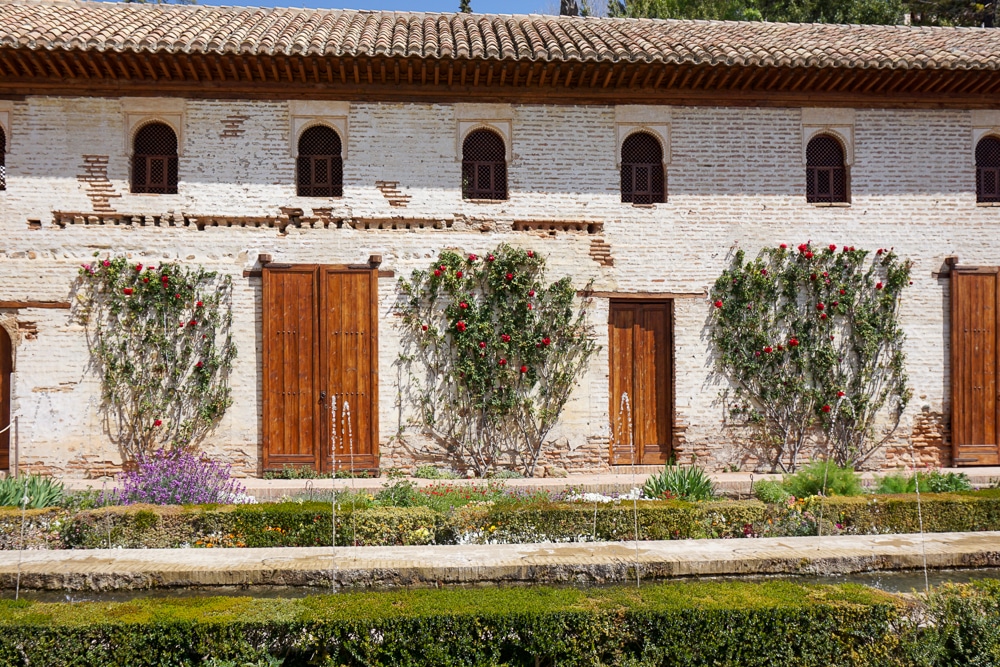
In addition to making sure you have your tickets, there are a few more tips for visiting the Alhambra you should know to ensure your visit is enjoyable.
Don’t forget your passport!
Typically, I leave my passport stored and locked away wherever I am staying. However, in this instance, you must have your passport. After getting your tickets well in advance, this is perhaps the most important detail to remember on the day of your Alhambra visit.
Every person needs to carry their own document. It must be the original document and not a photocopy or photo of the document on your phone. Children under 12 years old must have the identity document number of the adult they’re with written on their ticket.
Please don’t forget your passport or you won’t be allowed in!
Carry your ticket with you.
Everyone visiting the Alhambra needs to carry a printed-out ticket with the QR code or have their ticket in digital format on a device like a smartphone. This is for both children and adults.
Know the areas of the Alhambra.
The Alhambra is huge and there are countless areas, but broadly speaking it’s divided into the Nasrid Palaces, the Generalife, the Palacio de Carlos V, the Partal, and the Alcazaba as described above.
To make the most of your visit to the Alhambra, read the history and area descriptions in this article to get an idea of what you want to see and which areas to prioritize on your visit.
You can also download the official Alhambra map or get a paper copy once you’re there to help you navigate.
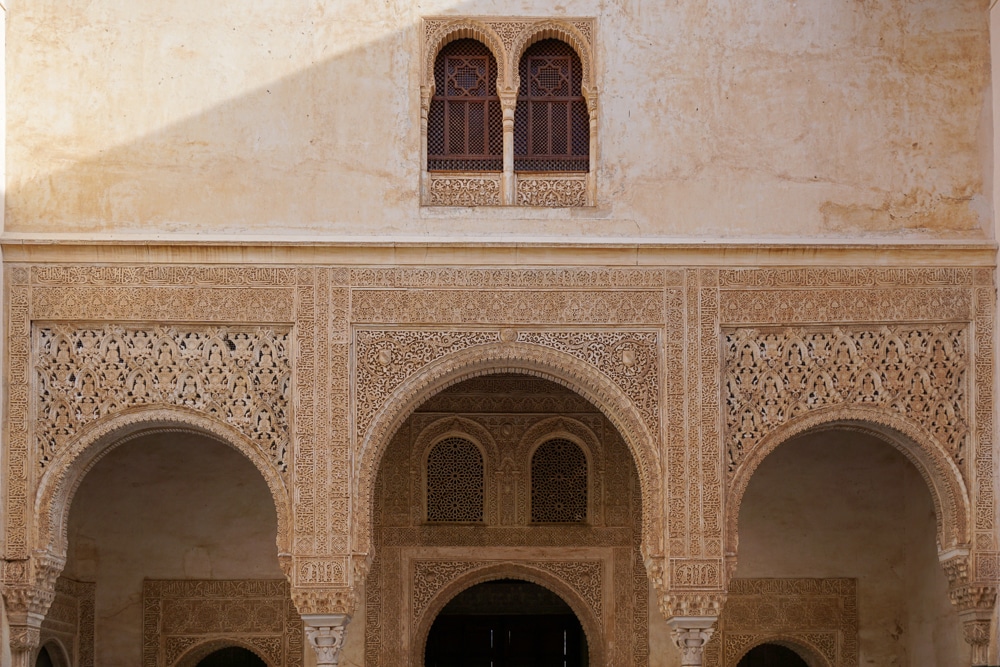
What to Wear Visiting the Alhambra
Who doesn’t want to look great in their vacation photos, especially when visiting an iconic palace like the Alhambra?!
But, it’s also a long day and you’ll be walking a lot. Make sure you wear comfortable shoes and that you’re well protected from the sun (hats are a must!) if you’re going in summer. If you end up needing to wait in long lines, you’ll be thankful for the ability to create your own shade.
If you’re visiting in fall or winter, be sure you’ve got extra layers to protect against the chill. You’ll be outdoors and in unheated or open-air palaces and monuments with no protection from the cold.
Most of the paths around the Alhambra are also cobblestoned and very uneven, so boots or sandals with a heel are not practical and could be unsafe, especially when you’re focusing on the artistic beauty around you and not something you could potentially trip over on the ground.
Bring snacks and drinks.
There’s not much in the way of restaurants and cafes once you’re inside the Alhambra. You’ll find some small snack bars selling things like simple sandwiches and something to drink.
However, I recommend bringing a big bottle of water, a picnic lunch, and some extra snacks in your backpack. Visiting the Alhambra takes on average 3 hours so you’ll be thankful to have a few things with you when you’re feeling peckish or thirsty.
Just be sure to eat and drink in the proper designated areas.
Remember to take photos at the most iconic spots.
There are photo-worthy spots all over the Alhambra, and it’s tempting to spend the whole visit snapping away. But remember to put your phone and cameras away and really enjoy your time there, too.
That said, you will want some vacation photos at the most iconic spots to show to your friends and family once you get home! I’d say you can’t leave without taking pictures at the Patio de los Arrayanes, in the center of the staterooms of the Nasrid Palaces, and the Patio de los Leones (the famous Court of the Lions).
Just remember, tripods, selfie sticks, and other similar accessories aren’t allowed inside the Alhambra. Similarly, flash isn’t allowed even during a nighttime visit to the Alhambra.
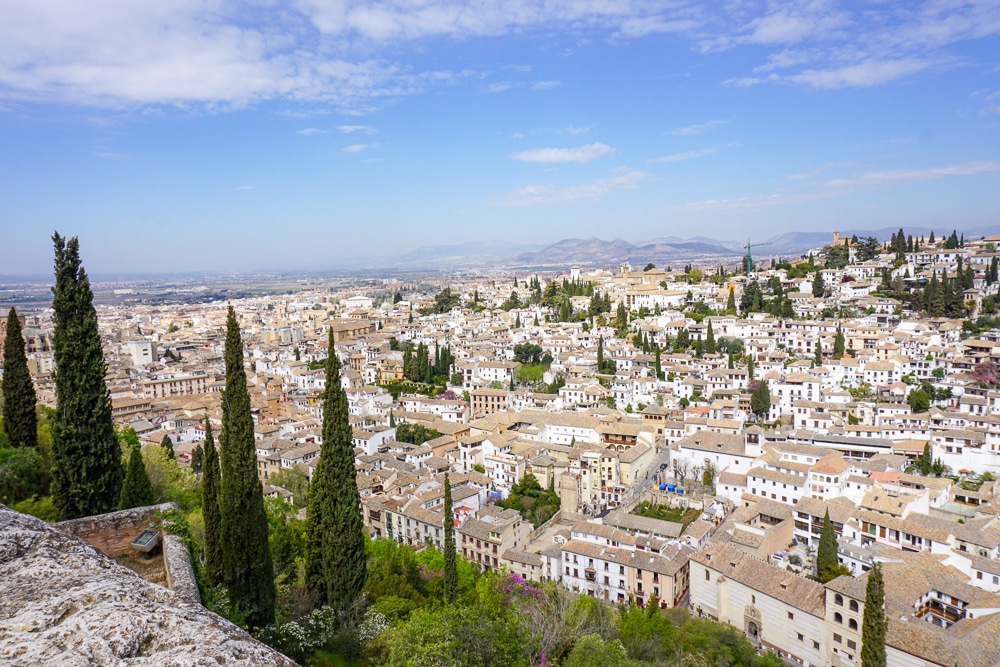
Go to a Lorca y Granada Event in the Generalife Gardens.
Every year the Alhambra hosts a series of events throughout the summer as part of their “Lorca y Granada” festival. To celebrate the notorious writer (Federico Garcia Lorca), they explore different aspects of his life through dance and theater.
If you visit during this event, you could get to see their flamenco and ballet show, which brings the best of the two styles together in one elegant and powerful production.
Plus, getting all dressed up and walking through the Alhambra in your nicest clothes with a glass of wine in one hand and views over the city stretching out before you is quite something!
Book in advance if you want to ensure you get tickets!
After Visiting the Alhambra – Sunset from San Nicolas Square
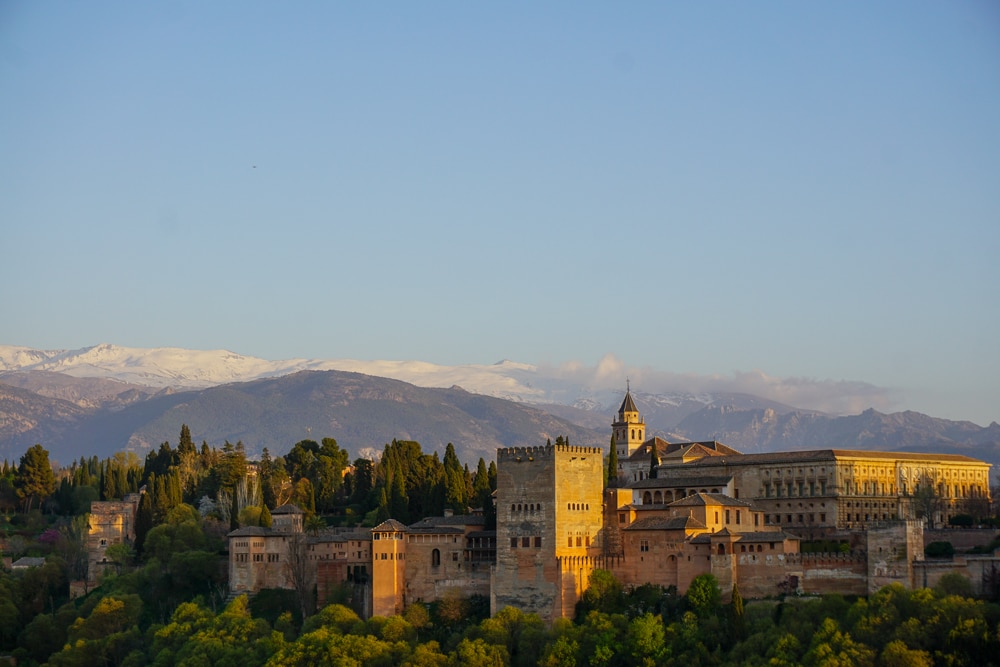
San Nicolas Square is in the Albaicin neighborhood and is a perfect (and popular!) viewpoint for sunset views and the glow of the light as it reflects off the Alhambra. Quite simply, the view is spectacular with the snow-capped Sierra Nevada Mountains in the background.
Expect crowds to gather as sunset gets closer. It was still possible to squeeze into a spot to take photos but I would recommend snagging an open spot and staying in it until you’re ready to leave. If you want this viewpoint to yourself, you’ll need to go during the early part of the day or later on once it’s dark. I think it’s a perfect way to cap off the day after having visited the Alhambra.
If you’re like me and like to take lots of photos, it’s great to arrive just before sunset and stay until after sunset. You can photograph the Alhambra with the perfect soft glow of dusk until the lights of the Alhambra illuminate the outside of the complex.
Use Google Maps to find Mirador de San Nicolas to know exactly where the viewpoint is.
Getting to the Alhambra
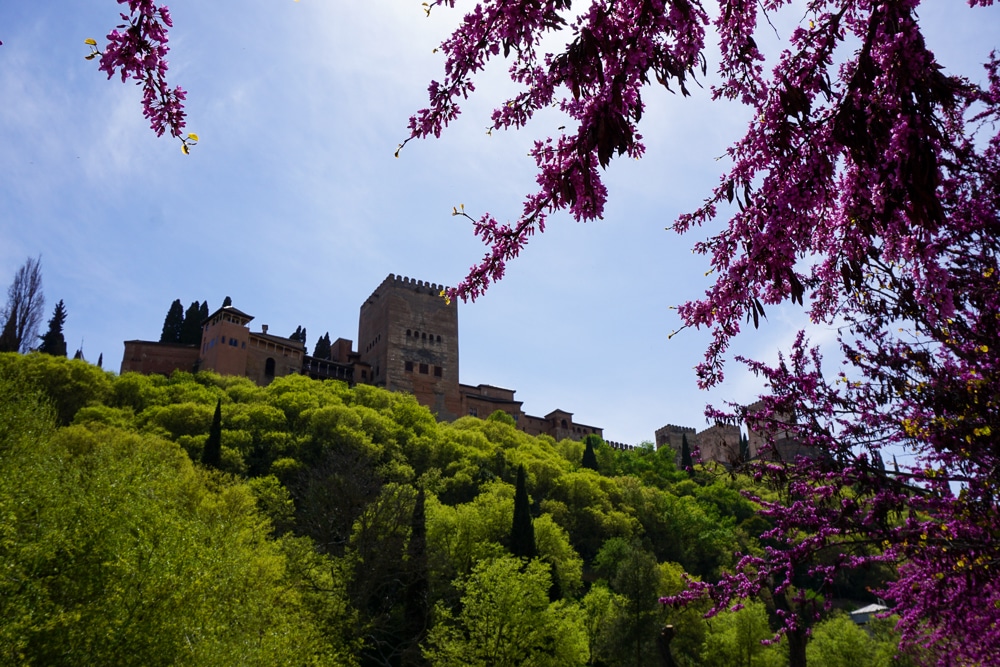
Depending on where you’re staying and what time your visit is, there are a few different ways to get to the Alhambra. If you’re staying in the Albaicin neighborhood and you’re up for a stroll, you can walk to the Alhambra.
The way is a little steep, but it’s very scenic and it takes you through some of the cutest streets in the city. If you start your walk at Plaza Nueva and climb up the Cuesta de Gomerez, you’ll arrive at the Gate of the Pomegranates, a gorgeous Renaissance gateway built by Carlos V. The entrance to the Nasrid Palaces is a little way to your left from there.
Another way to get there is from the Palacio de los Tristes. From there, cross the river and head up the Cuesta de Rey Chico (cuesta means hill in Spanish by the way, so don’t expect to escape the steep climb if you take this route) that winds its way along the side of the palace and brings you to the main entrance.
Finally, you can also start at the Plaza del Realejo and climb up the Cuesta del Realejo.
If you’re not a fan of hills or you’ve got to be there really early, there are buses that drop you off just outside the main entrance of the Alhambra.
You can catch a bus from Plaza Nueva. Numbers 30 and 32 run from just after 7 a.m. to 11 p.m. and a single one-way trip is 1.40€.
Visiting the Alhambra Bottom Line
The Alhambra is a can’t-miss sight! But it does take some advance planning to make sure you can visit on the day that makes the most sense for your trip to southern Spain.
Not to worry though! Put the knowledge and tips from this guide into practice and you’re sure to have an unforgettable visit to the Alhambra.
So, what are your questions about visiting the Alhambra?
Like this post? Please share it using the social media buttons.
